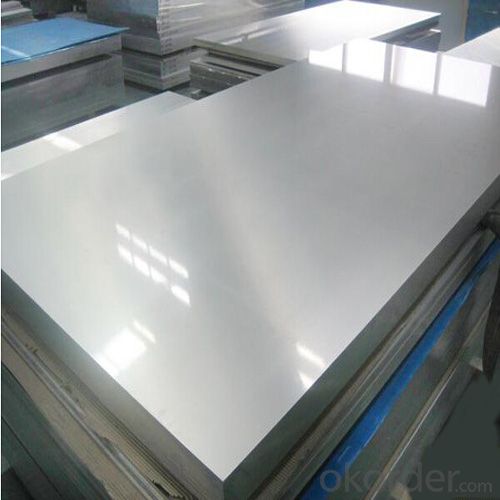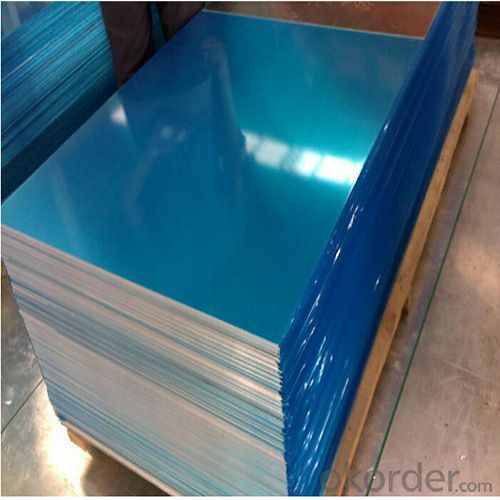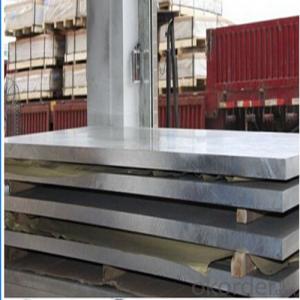Aluminum Thick Plate for shoes mold 6061
- Loading Port:
- Shanghai
- Payment Terms:
- TT or LC
- Min Order Qty:
- 5 m.t.
- Supply Capability:
- 10000 m.t./month
OKorder Service Pledge
OKorder Financial Service
You Might Also Like
Item specifice
1.Structure of Aluminum Thick Plate for Shoe Molds Description:
Our company can supply aluminium thick plates 6061. The thickness is 2mm-250mm, the common surface is polished with clear PVC film. The temper is T6, T651, F, H ect.
2.Main Features of Aluminum Thick Plate for Shoe Molds :
Good Corrosion Resistance
Good Machinability
High Quality
Competitive Price
3. Aluminum Thick Plate for Shoe Molds Images:



4. Aluminum Thick Plate for Shoe Molds Specification:
| Specification | Name: 6000 series Aluminum Plate | |||||||||||
| Alloy: 6061, 6082 etc. | ||||||||||||
| Temper: O, H112, T6, T651 etc. | ||||||||||||
| Thickness: 6-200mm | ||||||||||||
| Width: Up to 1500mm | ||||||||||||
| Surface treatment: mill finished, Print marks | ||||||||||||
| Feature | Machinability: In the harder T 4 and T6 tempers it is good. It is notably less easy to machine in the annealed temper. | |||||||||||
| Forming: Easily cold worked and formed in the annealed condition. Stamping, bending, spinning, deep drawing are all readily accomplished using standard methods. | ||||||||||||
| Welding: It has very good welding characteristics and may be welded by all of the common welding techniques. | ||||||||||||
| Heat Treatment: Solution heat treat at 990 F for adequate time to allow for thorough heating and then water quench. Precipitation hardening is done at 320 F for 18 hours and air cool, followed by 350 F for 8 hours and air cooling. | ||||||||||||
| Forging: It is capable of being hot forged at temperatures in the range of 900 F to 750 F. | ||||||||||||
| Hot Working: Hot working may be done in the temperature range of 700 F to 500 F. | ||||||||||||
| Cold Working: Cold working in the O temper condition is readily performed. The alloy is notably less easy to cold form in the T 4 and T 6 tempers. | ||||||||||||
| Annealing: Annealing should be done at 775 F for 2 to 3 hours followed by controlled cooling at 50 f per hour down to 500 F, then air cool. | ||||||||||||
| Aging: The aging precipitation heat treatment is done at 350 F for 8 hours followed by air cooling. This produces the T6 temper. | ||||||||||||
5.FAQ
Q1.How long have you been in this product?
A1:More than 10 years.
Q2. What's the minium quantity(MOQ)?
A2. 5 Metric tons
Q3. How long is shipping time?
A3. 7 (ready-made products)-25 days(OEM)
Q4. How do you guarantee the quality?
A4. 1. Cooperating and Exchaning experience with sevral quoted aluminum companies
2. Japanese and Swiss production line and skilled works (regular training and testing)
3. more than 10 years production experience.
Q5. Do you have after sale service?
A5. Yes. Any quality problem occurs within one year, pls take photoes,we will be responsible.
- Q:How does the surface treatment affect the corrosion resistance of aluminum sheet?
- The surface treatment of aluminum sheet plays a significant role in enhancing its corrosion resistance. Aluminum is inherently corrosion-resistant due to the formation of a thin oxide layer on its surface. However, this oxide layer is not always sufficient to protect the metal from aggressive environments or harsh conditions. Surface treatments such as anodizing, chromating, or painting can provide an additional protective layer on the aluminum sheet, significantly improving its corrosion resistance. Anodizing involves creating a controlled oxide layer on the surface of the aluminum through an electrochemical process. This layer is highly resistant to corrosion, offering excellent protection against various corrosive agents. Chromating, on the other hand, involves the application of a chromate conversion coating, which forms a thin film on the aluminum surface. This coating acts as a barrier, preventing corrosive substances from reaching the metal and causing oxidation. It also enhances the adhesion of subsequent paint or adhesive layers. Painting is another commonly used surface treatment for aluminum sheets. The application of a paint layer not only protects the metal from corrosion but also provides an aesthetic finish. The paint acts as a physical barrier that shields the aluminum from moisture, chemicals, and other corrosive elements. The choice of surface treatment depends on the specific application and the level of corrosion resistance required. Anodizing is often preferred for aluminum sheets used in construction, automotive, and aerospace industries, as it provides excellent corrosion protection and improves the appearance of the metal. Chromating is commonly used in electrical and electronic applications, as it offers both corrosion resistance and electrical conductivity. Painting is suitable for applications where aesthetics and corrosion protection are equally important, such as architectural elements or consumer products. In conclusion, the surface treatment of aluminum sheet significantly affects its corrosion resistance. Anodizing, chromating, and painting all contribute to enhancing the protective properties of aluminum against corrosion, thereby extending its lifespan and ensuring its durability in various environments.
- Q:What are the different methods of surface finishing for aluminum sheet?
- Aluminum sheets can undergo various surface finishing methods, each with its own distinct characteristics and advantages. Some commonly used methods include anodizing, painting, powder coating, polishing, and brushing. Anodizing is a widely employed technique that forms a protective oxide layer on the aluminum's surface. This process not only enhances the sheet's appearance but also improves its resistance to corrosion and durability. Anodized aluminum sheets are available in different colors and finishes, making them suitable for diverse applications. Painting is another frequently used method where a layer of paint is applied to the aluminum sheet to provide both decorative and protective coating. This approach allows for a wide range of colors and finishes, enabling customization and design versatility. Moreover, painting can enhance the sheet's resistance to weathering and scratches. Powder coating involves applying a dry, powdered coating to the aluminum sheet, which is then heated to create a durable and uniform layer. This technique offers excellent protection against corrosion, chemicals, and UV rays, making it ideal for applications requiring high durability and weather resistance. Polishing is a surface finishing method that employs abrasive materials to create a smooth and shiny surface on the aluminum sheet. This technique is commonly used to enhance the sheet's aesthetic appeal by eliminating imperfections and scratches. Polished aluminum sheets are often used in decorative applications where a reflective and lustrous surface is desired. Brushing is a process that gives the aluminum sheet a textured surface using abrasive brushes or pads. This method creates parallel lines or patterns on the sheet, resulting in a distinctive and attractive appearance. Brushed aluminum sheets find applications in architectural and interior design, as well as in the manufacturing of household appliances and automotive components. In conclusion, the various surface finishing methods for aluminum sheets offer a range of options to enhance their appearance, durability, and functionality. Whether it is anodizing, painting, powder coating, polishing, or brushing, each method brings unique benefits that can be tailored to specific applications and design requirements.
- Q:What are the different types of alloys used for painted aluminum sheets?
- There are various types of alloys used for painted aluminum sheets, including the commonly used 3003 and 5052 alloys. These alloys offer excellent corrosion resistance and formability, making them suitable for a wide range of applications. Additionally, other alloys such as 6061 and 7075 are utilized for their high strength properties in more demanding or specialized applications.
- Q:what will happen when aluminum sheet is put into copper chloride solution?
- the chemical equation of the reaction, 2Al+3CuCl2=2AlCl3+3Cu, the phenomena when aluminum sheet is put into copper chloride solution: there is red solid generating on the surface of aluminum sheet.
- Q:Can aluminum sheets be used for electronic devices?
- Yes, aluminum sheets can be used for electronic devices. Aluminum is widely used in the electronics industry due to its excellent conductivity, lightweight nature, and thermal management properties. It is commonly used as a base material for printed circuit boards (PCBs), heat sinks, enclosures, and other components in electronic devices.
- Q:What's the difference between laser cutting aluminum plate and stainless steel plate?
- The absorptivity of aluminum plate and stainless steel plate to laser is different. The aluminum plate is more reflective and easier to be removed during cutting
- Q:Can aluminum sheets be etched or engraved?
- Indeed, it is possible to etch or engrave aluminum sheets. The process entails removing a portion of the material from the surface by utilizing acid or a laser with substantial power. This technique allows for the creation of detailed designs, patterns, or even textual elements on the aluminum sheet. The applications for etching or engraving are diverse, including signage, decorative items, and industrial components. To achieve the desired appearance, color or other finishes can be added to further enhance the resulting design on the aluminum sheet.
- Q:What are the different types of surface treatments available for marine-grade aluminum sheets?
- There are several different types of surface treatments available for marine-grade aluminum sheets, each offering unique benefits and characteristics suited for various applications. 1. Anodizing: This process involves creating a protective oxide layer on the surface of the aluminum sheet through electrolysis. Anodized aluminum sheets offer excellent corrosion resistance, improved durability, and can be colored or dyed to enhance aesthetics. 2. Powder Coating: Powder coating involves applying a dry powder onto the aluminum sheet, which is then cured through heat to create a tough and durable coating. Powder-coated aluminum sheets provide excellent resistance to corrosion, abrasion, and fading, while also offering a wide range of color options. 3. Polishing: Polishing removes any imperfections on the surface of the aluminum sheet, resulting in a smooth and shiny finish. This surface treatment is often used for decorative purposes, enhancing the visual appeal of marine-grade aluminum sheets. 4. Brushing: Brushing involves creating a textured surface on the aluminum sheet using abrasive pads or brushes. This treatment is commonly used to hide scratches or imperfections and can provide a unique aesthetic appearance. 5. Chemical Conversion Coating: This treatment involves applying a chemical solution onto the aluminum sheet, which reacts with the surface to form a protective coating. Chemical conversion coatings enhance the corrosion resistance of the aluminum and can also serve as a base for further surface treatments, such as painting. 6. Clear Coating: Clear coating involves applying a transparent protective layer onto the aluminum sheet. This treatment helps to prevent corrosion and oxidation, while also maintaining the natural appearance of the aluminum surface. It is important to consider the specific requirements and intended use of the marine-grade aluminum sheets when choosing a surface treatment. Each type of treatment offers different characteristics in terms of corrosion resistance, durability, aesthetics, and cost, allowing for customization based on the specific needs of the application.
- Q:Are aluminum sheets suitable for decorative lighting fixtures?
- Yes, aluminum sheets are highly suitable for decorative lighting fixtures. Aluminum is a lightweight and versatile material that is easy to work with and manipulate into various shapes and designs. It offers excellent corrosion resistance, making it suitable for both indoor and outdoor lighting fixtures. Additionally, aluminum can be easily coated or painted to achieve different finishes, allowing for endless design possibilities. Its reflective properties also contribute to enhancing the overall lighting effect, making it an ideal choice for decorative lighting fixtures.
- Q:What is the typical modulus of elasticity for aluminum sheets?
- The typical modulus of elasticity for aluminum sheets is around 70 GPa (Gigapascals).
1. Manufacturer Overview |
|
|---|---|
| Location | |
| Year Established | |
| Annual Output Value | |
| Main Markets | |
| Company Certifications | |
2. Manufacturer Certificates |
|
|---|---|
| a) Certification Name | |
| Range | |
| Reference | |
| Validity Period | |
3. Manufacturer Capability |
|
|---|---|
| a)Trade Capacity | |
| Nearest Port | |
| Export Percentage | |
| No.of Employees in Trade Department | |
| Language Spoken: | |
| b)Factory Information | |
| Factory Size: | |
| No. of Production Lines | |
| Contract Manufacturing | |
| Product Price Range | |
Send your message to us
Aluminum Thick Plate for shoes mold 6061
- Loading Port:
- Shanghai
- Payment Terms:
- TT or LC
- Min Order Qty:
- 5 m.t.
- Supply Capability:
- 10000 m.t./month
OKorder Service Pledge
OKorder Financial Service
Similar products
New products
Hot products
Hot Searches
Related keywords






























